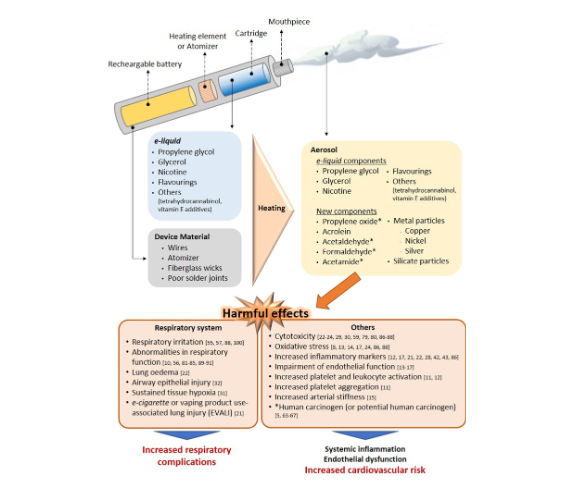By: Thalia Kaylyn Averil
Vapes or electronic cigarettes are becoming increasingly popular as people shift from using traditional cigarettes. Vapes are more accepted in society because they are perceived as a safer option. In the 1960s, a smoker and scrap dealer named Herbert Gilbert created a device that vaporized a liquid for inhalation, much like today’s electronic cigarettes. Even though it was once considered a better substitute for conventional cigarettes, vaping has now developed into a route to nicotine abuse, often causing more severe addiction effects than traditional cigarettes.
Vaping is claimed to help quit smoking. However, there are not many studies that support the success of vaping as a smoking cessation aid. In the end, many e-cigarette users also use conventional cigarettes, which can increase their health risks. The World Health Organization (WHO) does not support the use of e-cigarettes for the purpose of quitting smoking, the Central for Diseases Control and Prevention (CDC) also considers this a suggestive statement. This is proven by the large number of individuals who have succeeded in quitting smoking without special help. Therefore, the safety and efficacy of e-cigarettes as a tool for smoking cessation is still under debate due to a lack of relevant data.
E-cigarettes are devices designed to produce nicotine vapor without burning tobacco. These devices consist of a battery, a heating element, and a cartridge containing nicotine solution. When inhaled, the device heats the solution, creating vapor that can enter the lungs. Unlike conventional cigarettes, e-cigarettes do not involve combustion, so they do not produce sidestream smoke when not in use. Therefore, e-cigarettes are claimed to have fewer adverse effects on respiratory health. Although vapes emit vapor rather than smoke, some toxic substances (e.g. nicotine, carbonyls, metals) can still be released into the air, raising concerns about passive exposure, but research on their health effects is limited.
New compounds that may be more dangerous can be produced from the process of heating the liquid in the vape. The liquid used for e-cigarettes contains various chemicals, such as nicotine, propylene glycol, glycerol, and others. Heating propylene glycol, glycerol, and flavorings used for vaping can produce compounds that irritate the airways and cause inflammation, impaired heart function, and toxicity. The flavoring substances used have not been proven safe for inhalation, although they are safe for consumption, such as diacetyl which is often associated with bronchiolitis obliterans. Some compounds contained in vape also have the potential to cause cancer. In e-cigarette aerosol, there are toxic substances such as metals (arsenic, chromium, lead, nickel), aldehydes, tobacco alkaloids and hydrocarbons. The amount of substances absorbed in e-cigarettes has been shown to be the same or greater than conventional cigarettes.
Vaping weakens the body’s immune system, especially neutrophils and macrophages, as well as reducing its barrier function and disrupting the process of cleaning germs. In addition, vaping also increases signs of inflammation throughout the body and changes the composition of respiratory mucus, thereby reducing its cleansing performance. A decreased immune system can increase the ability of germs to cause disease and increase their adhesion, such as influenza, Staphylococcus aureus, and Streptococcus pneumoniae.

Figure 1. The effect of the heating process on the aerosol composition in the vape.
According to research, e-cigarettes are as dangerous as conventional cigarettes, so they are not a safe substitute for conventional cigarettes. Using e-cigarettes can have the same negative health impacts as using conventional cigarettes, such as reducing immunity and increasing the risk of cardiovascular disease, infections and dental problems. In addition, vaping use in adolescents is positively correlated with starting smoking later in life. The long-term effects of vaping are also still unclear. Therefore, using e-cigarettes is as bad as using regular tobacco cigarettes.
Resources
- Laucks P, Salzman GA. The Dangers of Vaping. Mo Med. 2020 Mar-Apr;117(2):159-164. PMID: 32308243; PMCID: PMC7144697. Available from: https://www.ncbi.nlm.nih.gov/pmc/articles/PMC7144697/
- Marques P, Piqueras L, Sanz MJ. An updated overview of e-cigarette impact on human health. Respir Res. 2021 May 18;22(1):151. doi: 10.1186/s12931-021-01737-5. PMID: 34006276; PMCID: PMC8129966. Available from: https://www.ncbi.nlm.nih.gov/pmc/articles/PMC8129966/
- Alotaybi M, Alzahrani SS, Algethmi AM, Alamri NS, Natto YS, Hashim ST, Altammar A, Alzubaidi AS, Alzahrani IB, Alghamdi AA. E-cigarettes and Vaping: A Smoking Cessation Method or Another Smoking Innovation? Cureus. 2022 Dec 12;14(12):e32435. doi: 10.7759/cureus.32435. PMID: 36644067; PMCID: PMC9833272. Available from: https://www.ncbi.nlm.nih.gov/pmc/articles/PMC9833272/
- Darabseh MZ, Selfe J, Morse CI, Degens H. Is vaping better than smoking for cardiorespiratory and muscle function? Multidiscip Respir Med. 2020 Jul 3;15(1):674. doi: 10.4081/mrm.2020.674. PMID: 32670575; PMCID: PMC7348661. Available from: https://www.ncbi.nlm.nih.gov/pmc/articles/PMC7348661/
- Czogala J, Goniewicz ML, Fidelus B, Zielinska-Danch W, Travers MJ, Sobczak A. Secondhand exposure to vapors from electronic cigarettes. Nicotine Tob Res. 2014 Jun;16(6):655-62. doi: 10.1093/ntr/ntt203. Epub 2013 Dec 11. PMID: 24336346; PMCID: PMC4565991. Available from: https://www.ncbi.nlm.nih.gov/pmc/articles/PMC4565991/
